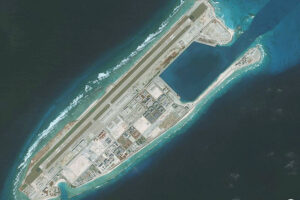CHINA has placed permanent rescue forces and maritime authorities on its artificial islands in the South China Sea, according to state-owned China Central Television.
Its flying squadron and maritime rescue and administration staff would be stationed at Fiery Cross, Subi and Mischief reefs in the Spratlys to boost rescue operations, says the media report.
This would transform a regular on-call rescue ship deployment into a permanent institutional presence that could improve the coverage of the southern area of the disputed waterway, it added.
The Chinese departments would “undertake maritime emergency rescue tasks, perform maritime traffic safety supervision and prevention of ship pollution and other duties in the Nansha waters,” state news agency Xinhua reported, using the Chinese name for the archipelago.
These would also “provide strong protection for the safety of ship navigation and daily production activities at sea for the people of coastal countries.”
“This is a concrete step for China to better provide public goods to the international community and actively fulfil its international responsibilities and obligations,” it added.
Dalian Maritime University Professor Shi Chunlin has said strengthened search and rescue capacities in the South China Sea would enhance China’s dominance over South China Sea affairs.
China has repeatedly called illegal a 2016 arbitral award by a United Nations-backed tribunal favoring the Philippines’ claims in the disputed sea where the Spratly Islands are located. The arbitration court voided China’s claim to more than 80% of the sea based on a 1940s nine-dash line map.
The South China Sea, a key global shipping route, is subject to overlapping territorial claims involving the Philippines, China, Brunei, Malaysia, Taiwan and Vietnam. Each year, trillions of dollars of trade flow through the sea, which is also rich in fish and gas.
The Spratly Islands have been divided by the International Maritime Organization (IMO) into several regions, complicating possible search and rescue operations in the area.
The Philippines claims the northeastern section of the island, calling it the Kalayaan Island Group, while Malaysia claims part of the Kalayaan Island. Meanwhile, China and Taiwan claim the entire island group.
Beijing is discussing with the Association of Southeast Asian Nations a plan to create a regional search and rescue cooperation platform for the whole South China Sea, according to Chen Xiangmiao, a research fellow at the National Institute for South China Sea Studies.
China’s new office is also meant to enhance communication and emergency response, he added. Distress signals can be sent to the International Maritime Organization or near maritime administrations.
The Department of Foreign Affairs did not immediate reply to a WhatsApp message seeking comment.
China Foreign Ministry spokesman Wang Wenbin this month said “China neither accepts nor recognizes it and will never accept any claim or action based on the award.” “By doing so, we are upholding international rule of law.”
Philippine Foreign Affairs Secretary Enrique A. Manalo has said the findings of the arbitration court “are no longer within the reach of denial and rebuttal, and are conclusive as they are indisputable.”
China is unlikely to restrain actions in the South China Sea after a military alliance of 30 western states labeled China a “systemic challenge,” Philippine-based political analysts have said.
During a recent summit in Madrid, the North Atlantic Treaty Organization (NATO) said China’s “attempts to undercut the rules-based international order run counter to our values and interests.”
NATO called out China’s “stated ambitions and coercive policies” and warned of the deepening strategic partnership between China and Russia, citing the latter as a threat with its continued aggression against Ukraine.
They criticized China’s defense-building and economic policies, among other aspects, but at the same time remain open to “constructive engagement” with China.
Top leaders of Japan, South Korea, Australia and New Zealand also attended the NATO summit for the first time. — Alyssa Nicole O. Tan

